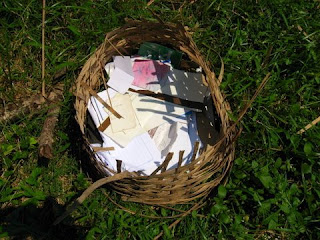
The upscale subdivision of
Ayala Alabang is undergoing a wave of empty lot suburban farming. Rising food prices, resurging interest in home cooking/quality of life and media attention about gardening have no doubt contributed to this pretty delightful way things are going.
Ayala Alabang is a gated "village" covering 700 hectares of what used to be rice fields and rural areas on the fringes of Metro Manila. It has large lots and wide roads, and it is virtually impossible to live there if you do not own a car. There are many empty lots which could serve as mini-farms to provide food to its 27,000 residents. People are not allowed to have storefronts that serve the residents, which results in everyone leaving for outside malls and groceries, sometimes in other cities.

Over the years, I have seen increased farming of native and low-maintenance plants in empty lots or in small and odd spaces. These are usually tended to by the household help or drivers, who posess typical Filipino rural skills in diversified and organic backyard farming. I consider them as heroes who are gifting us ignorant city folk with knowledge of appropriate land use and indigenous plants. Our household helper was responsible for teaching me the basics of plant identification, propagation, and culinary use.
I cannot stress enough how important this knowledge is, and that we are open to tapping into this vast resource base brought to us by urban migration. It will also make their lives better, having real conversations with the people they live with.

Anyhow, on to the gardens. Many plant easy-to-maintain herbs like lemongrass and basil. Greens like
saluyot (jute) and
alugbati (malabar spinach), and hardy okra, which thrive even in neglect, are common. Below is a beginning plot of green-stemmed
alugbati:

It is interesting to note the spreading of seeds and plants through blocks, and you will observe patterns. Some blocks have
kadyos, others do not.

To digress onto a somewhat related tangent (read on), in Alabang, it is usually only the household helpers and drivers who have any form of "neighborly interaction". The homeowners keep to themselves, for the most part. When the sun is not so hot (late in the afternoon, or after families leave in the morning), the helpers gather outside one or two homes, chatting with each other, sitting on the sidewalk or driveway. Other than these times, they talk to each other while opening the gate for their bosses' cars, throwing the garbage out.

(While I was walking around yesterday, there were two helpers talking loudly from opposite sides of the road, about dog troubles. Possibly he had eaten a poisonous insect, the older one speculated, maybe he should eat sugar. But he wouldn't eat anything, the other objected, and was then advised to mix sugar in water and let him drink it.)

It is probably during these idle times that helpers and drivers tend the non-gardens (I call them this because the green spaces inside the house are usually filled with ornamentals which they do not use for food or medicine), hence their choice of low-maintenance plants. Some have improvised watering devices such as old bleach (oh my) jugs with holes on the bottom for gradual release. It is probably also during their daily "helper community sessions" that they mention and exchange seeds/cuttings. Most of the plants do not have seeds available in the grocery and can be propagated only by buying a small plant or taking some for free from someone else.

Some lots are more openly and ambitiously farmed. The one below probably produces enough vegetables to feed one household, with a diversified lot of sweet potato, okra, corn, papaya, beans, and much more!



(I took some of the beans above for seed. I took lots of plants that day.)
If you are from Alabang or anywhere and want to start a little urban farm, you can email me at yapakyakap (sa) gmail (tuldok) com and we can get a little conversation going. I have given some advice to a few readers, and would be glad to meet up if you are close by to exchange ideas and seedlings.
Some posts on urban farming in my city (I would have actually name it suburban or peri-urban farming if I wrote it today.):
Urban Farming in ParañaqueUrban Farming in Parañaque, Part II





































